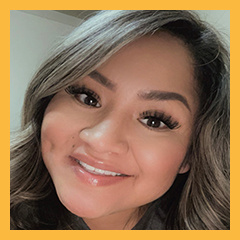ASK APRIA
Today's Clinician

Ashley Greyeyes
Ashley has been a Respiratory Therapist at Apria for nearly 7 years, and serves our patients in Colorado. In her spare time, Ashley enjoys spending time with her husband and 3 children. She also enjoys camping, traveling, RZR riding, and the Arizona Cardinals.
CPAP
Q. What is the sleep posture that you should try when using a CPAP device? Sleeping on my side gives my neck pain.
A. Side sleeping is the recommended sleep position for sleep apnea however the best position for PPAP therapy often depends on the mask type that you're using. Side sleeping is most comfortable with masks that have a minimum face covering like nasal pillows, masks, or cradles. If you're attempting to sleep on your side with a full-face mask, this may be contributing to your neck pain.
If you are not comfortable sleeping on your side, you can try to sleep on your back or stomach. Back sleeping is better for patients with high pressure settings on their CPAP or people who use a full-face mask. Although sleeping on your back can worsen sleep apnea symptoms, the use of your CPAP device should help to address and control your sleep apnea.
Stomach sleeping can be done but you have to make sure your mask is not pressing into your face and that the exhalation port isn't blocked.
A CPAP pillow is designed to support your neck, mask, and CPAP tubing, alleviating any tension. You may find a more comfortable sleep position and a more restful night’s sleep with the use of a CPAP pillow.
Q. How do I stop skull dents from happening when I wear my CPAP mask?
A. There are a few things you can do to stop your CPAP mask from causing little dents in your face and/or skull:
- Make sure you are wearing the appropriately sized headgear for you. If your mask is too small it can lead to dents on your scalp, and on the flipside if your mask is too large, many people will compensate by making the straps a lot tighter, also leading to little dents.
- If you have the appropriate size mask, adjust your headgear, as it may just be too tight. You want your mask to be snug enough to prevent leaks, but you don’t want it so tight that its causing dents, pain, or headaches.
- Try a CPAP mask liner to provide a barrier between your skin and the mask. These help with both skin irritation and pressure, as well as helps to prevent leaks.
- Add a cushion to your CPAP straps so that what is touching your head has padding to prevent unwanted pressure.
- You may consider trying a different mask. You can work with your local Apria Respiratory Therapist to find a different mask style that better suits you. We have a variety of full face, nasal pillow, and nasal masks, and we can help with mask fitting via Telehealth or in-person at your local Apria branch.
Q. Is there a video that can help show me how to set up my device and maintain it? I can’t figure out how to disassemble my mask.
A. Yes! Apria has videos to reference if you’re needing assistance with setting up and maintaining your CPAP device. To set up your CPAP device, select the model that you are using on our Patient Welcome page and a video will show you how to get started. Additional videos that can help you with CPAP troubleshooting and offer some tips and tricks are available on our Video Resources page. As always, if you need further assistance, please contact an Apria Respiratory Therapist.
Q. Do I need to change the water in my humidifier daily? How often should I replace it? And is tap water ok?
A. It's recommended to change the water used for your CPAP therapy daily to prevent any bacteria growth in your humidifier.
You will want to empty the chamber after use in the morning, rinse, and let the chamber air dry until you're ready to use it at night. Make sure to clean the water chamber weekly with some dish soap and water so that you can properly clean away any potential bacteria or mold. Even with regular cleaning, you should be replacing the water chamber every 6 months.
It’s suggested to always use distilled water, even for cleaning, to prevent any mineral buildup or corrosion in the water chamber.
Q. If I get up in the middle of the night to use the bathroom, what’s the easiest way to disconnect my mask?
A. The easiest and fastest way to disconnect the mask is using the quick release. The quick release on your mask will look like an elbow, swivel connect, or a short tube and allows you to easily disconnect your mask from the CPAP tubing. It's ideal to use the quick release because it leaves the mask on your face when you get up to use the bathroom, and you only have to reconnect the tubing to your mask when you are back in bed (instead of putting the whole mask back on).
Do you have a question for our Respiratory Therapists to be answered in a future email?
We want to hear from you!


.jpg?width=1120&height=376&name=AD-EmailBanner-TopSellingComfort_03.19.24%20(5).jpg)